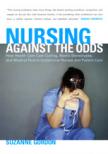R.N.'s in Crisis
When I was in junior high, I decided, after reading every Cherry Ames book in the public library, to become a nurse because nursing sounded interesting and fun. I went to Georgetown University and discovered that nursing was professionally and intellectually challenging. During my first job in a large hospital, I found nursing was all I hoped it would be.
But nursing today, as this well-documented and disturbing book by award-winning journalist Suzanne Gordon makes clear, is none of those things.
Nursing Against the Odds examines the challenges of nursing from three perspectives: the nurse-physician relationship; the media’s portrayal of nurses and the nursing profession; and the effects of managed care and hospital restructuring.
Gordon traces the dysfunctional relationship between physicians and nurses to the early days of hospitals, when physicians first feared that religious nurses, being part of autonomous communities, would question their hierarchy of power. Later, the author notes, physicians were suspicious that reforms by lay nurses, inspired by Florence Nightingale, would lead to over-training and ultimately the emancipation of women. From nursing’s earliest days, nurses were treated with little respect and were taught not to challenge doctors’ orders.
According to Nursing Against the Odds, the situation has not changed much. On a daily basis, writes Gordon, nurses work with physicians who fail to communicate with them about critical clinical issues, deny them access to needed information and resources, subject them to verbal abuse when they try to do their job, and misinterpret collegial disagreements about clinical issues as challenges to medical authority and hierarchy.
The consequences of this dysfunctional relationship can be deadly. Gordon recounts stories in which physicians’ ignoring nurses’ concerns led to unnecessary death and injury. Nearly as chilling is a story in which a nurse’s opinion was heard and the patient did fine. The patient was just staring into space, almost catatonic. The nurse who was taking care of him told the doctor she thought the patient was having seizures and suggested that they give him Valium. After much discussion, the doctor finally agreed. The patient got the Valium and woke right up. Instead of thanking the nurse, the doctor said, I hate it when the nurses are right.’
The second theme of Nursing Against the Odds is the unfavorable fictional depictions of nurses that have shaped negative attitudes about the nursing profession. From children’s books to movies to television shows, Gordon says that with few exceptions, when they are not depicted as villains, nurses tend to be portrayed as bystanders, spectators instead of central participants in the health care drama. For example, in the mid-1990’s television drama Chicago Hope, the three central characters were two surgeons and a chief operating room nurse. While the doctors were involved in life and death situations, week after week the nurse fretted over her failing marriage.
Gordon believes that the media’s constant trivialization of nursing has serious ramifications for real life nurses and their patients: Nursing will become attractive only if it is well paid and well respected. For nurses to be truly respected, the public needs to know what nurses really know and what they really do.
According to Gordon, hospital restructuringthe book’s third themehas posed the most serious threat to nursing. Starting in the early 1990’s, the growth of managed care forced competition among hospitals, which led to discounted prices. Hospitals, in an effort to reduce costs, turned to management consultants and a cadre of young M.B.A.’s who applied models and formulas from industry.
Since nursing received the largest share of the hospitals’ labor budgets, observes Gordon, nursing was not only a logical, but an easy place to start cutting costs. The stage was thus set to target nurses for massive layoffs, to deprofessionalize the nursing practice, to jeopardize quality patient care, and ultimately, to create a massive shortage of nursing care and the nurses who would provide it.
Promising millions of dollars in savings, consultants restructured nursing staffs, claiming to create patient-centered care, which was an Orwellian way of describing the very opposite. Inadequately trained nurse’s aides replaced many licensed nurses at the bedside. Most clinical specialists lost their jobs, and in many hospitals more than half the nursing supervisors were fired. Nurses who complained about the changes were called obstructionists and told they were interfering with progress.
Staffing was cut and patient acuity increased. Patients were sicker, as managed care drove down lengths of stay, so workloads became more intense. Nurses worked through breaks and were asked to take on additional shifts. They experienced chronic stress, injuries and burnout. Lower standards led to accidents. As one nurse told Gordon, When you’re given 20 patients when you should have six, well, you’re only so good.
A nurse from Beth Israel Hospital in Boston, once famous for its nursing excellence, is quoted by Gordon as saying: It can be a wonderful career. It involves you intellectually, spiritually, creatively.... If you have the leadership and the tools, it’s all of that. At the B.I. we had all that. And then they took it all away.
The result has been overwhelming dissatisfaction among nurses, leading to the severe nursing shortage we have today. Many nurses, unhappy with mandatory overtime and longer shifts, left the profession. When nurses believe that exit is their only option, they are really expressing their profound sense of defeat. In effect, they are raising a white flag and admitting that the work of caring for the sick is not good, will never be any good, and thus, the only way to adapt is to get in and out as quickly as possible.
Nursing Against the Odds is an important book. It is likely to serve as the catalyst for frank discussion among nurses, physicians and health care administrators. Is this true? they will ask. And if it is, what are we going to do about it?
This article also appeared in print, under the headline “R.N.'s in Crisis,” in the October 17, 2005, issue.








